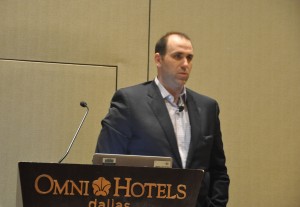In every industry, there’s one perennial challenge - how do you consistently delight your customers? How do you show them that you instantly know who they are, no matter when or where they interact with you? How do you turn them from lukewarm acquaintances to passionate brand evangelists?
Scotiabank has asked itself those questions at least 21 million times – once for each of the customers it needs to know well. As Canada’s leading bank and a large presence in many other parts of the world, Scotiabank decided a couple of years ago to transform itself from a transactional bank to one that is relationship-oriented.

Tim Morris, Vice President of Customer Interaction Management at Scotiabank, presented at SAS Global Forum Executive Conference on how they use analytics to delight customers.
The first step was to connect and enhance the bank’s channels so Scotiabank’s customers don’t have to tell their story two, three or four times before they get what they need. (We all know how that feels, right?) After building the connections, the bank had to make the information available to its front-line reps so they could see all customer interactions in a single portal. Having a single hub is what ensures that the right conversation happens at the right time, a definite first step to delight customers.
After that foundational work was done, it was time to rethink the bank’s lead strategies to develop “next best activities” that would take Scotiabank from a product focus to a customer focus. The goal is to always have it be about:
One Customer, One Bank.
In other words, every arm of the bank needs to be talking to each other, and hearing each other. If you know, for instance, that Maggie is a seasoned traveler with great credit and your credit division has just issued her a new card, your fraud department better not decline her transactions when she goes overseas.
Morris offered some advice for others who are embarking on similar journeys. The main message? Traditional project management approaches won’t cut it. Frontline customer representatives will be faced with three types of change: core change, context change, and content change. None of these changes are easy, so executive-level support is key.
“We see it as a moral mandate,” says Morris. “Everyone at Scotiabank gets it and knows why we’re doing it.” And if anyone ever forgets, there are 21 million reminders of just how strong the bank can be, if it knows its customers as well as it can.
For more details about how Scotiabank uses analytics in its marketing, read how Scotiabank mines data to meet customer needs by using marketing optimization to delight its customers.
